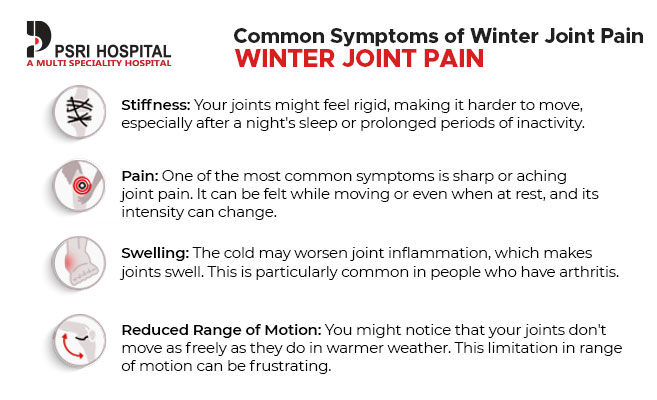Everything You Need To Know About Joint Pain In Cold

Winter brings its own set of challenges, and for many people, one of them is dealing with disturbing joint pain. If you’ve ever wondered why your joints ache more in the cold, or if you’re looking for ways to ease that discomfort, you’re in the right place. In this blog, we’ll cover everything you need to know about the effect of cold weather on joints, common symptoms, and simple ways to reduce winter joint pain.
Effect of Cold Weather on Joints
Have you ever noticed that your joints seem to complain more when the temperature drops? Well, you’re not alone. Cold weather can have a direct impact on your joints, especially if you have conditions like arthritis. When the mercury falls, your joints might feel stiffer, and movements may become more challenging.
Our body tissue surfaces are subjected to the weight of the air pressing all around. This constant pressure ensures tissues do not swell up. As environmental temperature dips or as changes in humidity happen, there is a drop in barometric pressure in the air. This drop in pressure allows tissue to swell and accumulate inflammation, which causes joint and muscle pains.
Along with this pressure drop, anything humid or cold can cause ligaments or muscles and tendons to tighten up. Additionally, the surrounding muscles may tense up, adding to the overall unease. This gives a feeling of body and joint stiffness.
Common Symptoms of Winter Joint Pain

So, if you are also suffering from these symptoms, visiting the best joint replacement hospital in India can help you get the proper treatment.
Ways To Reduce Winter Joint Pain
Now that we know why cold weather affects joints let’s explore some simple strategies to help alleviate winter joint pain.
Stay Warm
It may sound obvious, but keeping warm is crucial. To keep the heat near your body, wear layers of clothing. Remember to protect the areas of your body where joint pain is frequently more severe by wearing gloves, socks, and a hat.
Keep Moving
Although it may be tempting to stay in bed during the winter, an active lifestyle is essential for joint health. Swimming and walking are excellent mild exercises to maintain joint flexibility. Avoid high-impact activities that may put additional strain on your joints.
Warm-Up Properly
Warm up for a while before doing any physical activity. Light stretches and movements that increase blood flow to the joints reduce the risk of stiffness and injury.
Maintain a Healthy Weight
Your joints, particularly the ones in your lower body, are subjected to additional strain when you are overweight. Your joints will be less stressed if you maintain a healthy weight with regular exercise and a balanced diet.
Stay Hydrated
Water consumption is essential for joint health. Maintaining the viscosity of the synovial fluid in your joints through proper hydration facilitates more fluid movement.
Use Hot and Cold Therapies
Applying heat packs or taking warm baths can help relax tense muscles and soothe joint pain. On the other hand, cold packs can help reduce inflammation. Alternate between hot and cold therapies for optimal relief.
Consider Joint Supplements
Consult with your healthcare provider about the potential benefits of joint supplements, such as omega-3 fatty acids or glucosamine. These supplements may support joint health and reduce pain for some individuals.
Conclusion
Winter joint pain is a common concern, but with a few simple adjustments to your lifestyle, you can make a significant difference. Remember to stay warm, keep moving, and adopt healthy habits to minimize the impact of cold weather on your joints. If you experience persistent or severe joint pain, it’s always a good idea to consult with a healthcare professional at PSRI Hospital, the best joint replacement hospital in India.
By understanding the effect of cold weather on joints and taking proactive steps to care for your joints, you can navigate the winter months with greater comfort and ease. Stay warm, and keep those joints moving! For further assistance, book an appointment now to know more.
FAQs
Q1: Why do my joints hurt more in cold weather?
A: Cold weather affects the fluids in your joints, making them thicker and less cushiony. This can lead to increased friction between the joints, causing stiffness and pain. Muscles around the joints may also tense up, adding to the discomfort.
Q2: What are the common symptoms of winter joint pain?
A: Common symptoms include stiffness, aching or sharp pain, swelling, and a reduced range of motion. Joints might feel rigid, and the pain can vary in intensity, moving challenging.
Q3: How can I reduce winter joint pain?
A: To reduce winter joint pain, stay warm by dressing in layers, keep moving with gentle exercises like walking, and warm up properly before any physical activity. Maintain a healthy weight, stay hydrated, and consider hot and cold therapies. Consulting your healthcare provider about joint supplements is also an option.
Q4: Is it essential to exercise in winter if I have joint pain?
A: Yes, staying active is vital for joint health, even in winter. Engage in low-impact exercises like walking or swimming to keep joints limber. However, avoid high-impact activities that may put extra stress on your joints.
Q5: Are there simple ways to ease joint pain at home?
A: Absolutely! Besides staying warm and keeping active, you can use hot and cold therapies like warm packs or baths to relax muscles and reduce inflammation. Maintaining a healthy weight, staying hydrated, and considering joint supplements under the guidance of a healthcare professional are also simple ways to ease joint pain at home.

 Book An Appointment
Book An Appointment Virtual Consultation
Virtual Consultation




